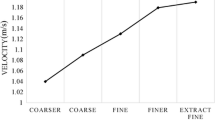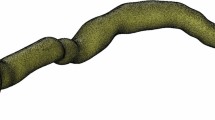Abstract
A recently reported angiographic technique for hemodynamic indices based on first-pass distribution analysis (FPA) could potentially be helpful for determining the culprit artery responsible for myocardial ischemia. The purpose of this study was to determinate the culprit coronary arterial branches based on coronary flow reserve (CFR) and fractional flow reserve (FFR) using only angiographic images. The study was performed in 14 anesthetized swine. Microspheres were injected into coronary arterial branches to create microvascular disruption. Stenosis was also created by inserting plastic tubings in LAD and LCX arterial branches. Adenosine was used to produce maximum hyperemia. Angiographic CFR (CFRa), relative angiographic CFR (rCFRa), and angiographic FFR (FFRa) were calculated by FPA. The diagnostic abilities of CFRa, rCFRa, and FFRa were compared in three models: (1) epicardial stenosis model (S), (2) microcirculation disruption model (M), and (3) combined(S + M) model by using the area under the ROC curve (AUC). The mean differences between FFRa and the pressure-derived FFR (FFRp) measurements were −0.01 ± 0.21 in S model (N = 37) and 0.01 ± 0.18 in M model (N = 53). From 225 measurements in S model, the AUCs for CFRa and FFRa were 0.720 and 0.918, respectively. From 262 measurements in M model and 238 measurements in (S + M) model, the AUCs for CFRa, rCFRa, FFRa were 0.744, 0.715, 0.959 and 0.806, 0.738, 0.995, respectively. The hemodynamic indices of the small branches (down to ~0.7 mm) could be measured using only angiographic image data. The application of FFRa could potentially provide a useful method to assess the severity of disease in coronary arterial branches.






Similar content being viewed by others
References
Pijls NH, Sels JW (2012) Functional measurement of coronary stenosis. J Am Coll Cardiol 59(12):1045–1057. doi:10.1016/j.jacc.2011.09.077
Yong AS, Daniels D, De Bruyne B, Kim HS, Ikeno F, Lyons J, Pijls NH, Fearon WF (2013) Fractional flow reserve assessment of left main stenosis in the presence of downstream coronary stenoses. Circ Cardiovasc Interv 6(2):161–165. doi:10.1161/CIRCINTERVENTIONS.112.000104
Zhang Z, Takarada S, Molloi S (2012) Quantification of absolute coronary flow reserve and relative fractional flow reserve in a swine animal model using angiographic image data. Am J Physiol Heart Circ Physiol 303(3):H401–H410. doi:10.1152/ajpheart.00153.2012
Takarada S, Zhang Z, Molloi S (2013) An angiographic technique for coronary fractional flow reserve measurement: in vivo validation. Int J Cardiovasc Imaging 29(3):535–544. doi:10.1007/s10554-012-0119-0
Carlsson M, Saloner D, Martin AJ, Ursell PC, Saeed M (2010) Heterogeneous microinfarcts caused by coronary microemboli: evaluation with multidetector CT and MR imaging in a swine model. Radiology 254(3):718–728. doi:10.1148/radiol.09090527
Molloi S, Kassab GS, Zhou Y (2001) Quantification of coronary artery lumen volume by digital angiography: in vivo validation. Circulation 104(19):2351–2357
Wong JT, Molloi S (2008) Determination of fractional flow reserve (FFR) based on scaling laws: a simulation study. Phys Med Biol 53(14):3995–4011. doi:10.1088/0031-9155/53/14/017
Molloi S, Chalyan D, Le H, Wong JT (2012) Estimation of coronary artery hyperemic blood flow based on arterial lumen volume using angiographic images. Int J Cardiovasc Imaging 28(1):1–11. doi:10.1007/s10554-010-9766-1
Zhang Z, Takarada S, Molloi S (2011) Assessment of coronary microcirculation in a swine animal model. Am J Physiol Heart Circ Physiol 301(2):H402–H408. doi:10.1152/ajpheart.00213.2011
Zhang Z, Molloi S (2013) A novel angiographic fractional flow reserve. Reply. Am J Physiol Heart Circ Physiol 304(8):H1176–H1177. doi:10.1152/ajpheart.00136.2013
Zhang Z, Takarada S, Molloi S (2011) Quantification of coronary microvascular resistance using angiographic images for volumetric blood flow measurement: in vivo validation. Am J Physiol Heart Circ Physiol 300(6):H2096–H2104. doi:10.1152/ajpheart.01123.2010
Spaan JA (2009) Coronary flow is not that simple! Heart 95(9):761–762 (author reply 762)
Gould KL, Lipscomb K, Hamilton GW (1974) Physiologic basis for assessing critical coronary stenosis: instantaneous flow response and regional distribution during coronary hyperemia as measures of coronary flow reserve. Am J Cardiol 33(1):87–94
De Bruyne B, Sarma J (2008) Fractional flow reserve: a review: invasive imaging. Heart 94(7):949–959. doi:10.1136/hrt.2007.122838
Pawlowski T, Prati F, Kulawik T, Ficarra E, Bil J, Gil R (2013) Optical coherence tomography criteria for defining functional severity of intermediate lesions: a comparative study with FFR. Int J Cardiovasc Imaging 29(8):1685–1691. doi:10.1007/s10554-013-0283-x
Mittal N, Zhou Y, Ung S, Linares C, Molloi S, Kassab GS (2005) A computer reconstruction of the entire coronary arterial tree based on detailed morphometric data. Ann Biomed Eng 33(8):1015–1026. doi:10.1007/s10439-005-5758-z
Spaan JAE, Piek JJ, Hoffman JIE, Siebes M (2006) Physiological basis of clinically used coronary hemodynamic indices. Circulation 113(3):446–455. doi:10.1161/Circulationaha.105.587196
Siebes M, Verhoeff BJ, Meuwissen M, de Winter RJ, Spaan JAE, Piek JJ (2004) Single-wire pressure and flow velocity measurement to quantify coronary stenosis hemodynamics and effects of percutaneous interventions. Circulation 109(6):756–762. doi:10.1161/01.Cir.0000112571.06979.B2
Min JK, Leipsic J, Pencina MJ, Berman DS, Koo BK, van Mieghem C, Erglis A, Lin FY, Dunning AM, Apruzzese P, Budoff MJ, Cole JH, Jaffer FA, Leon MB, Malpeso J, Mancini GB, Park SJ, Schwartz RS, Shaw LJ, Mauri L (2012) Diagnostic accuracy of fractional flow reserve from anatomic CT angiography. JAMA 308(12):1237–1245. doi:10.1001/2012.jama.11274
Johnson NP, Kirkeeide RL, Gould KL (2013) Coronary anatomy to predict physiology: fundamental limits. Circ Cardiovasc Imaging 6(5):817–832. doi:10.1161/CIRCIMAGING.113.000373
Wu Z, Ye F, You W, Zhang J, Xie D, Chen S (2014) Microcirculatory significance of periprocedural myocardial necrosis after percutaneous coronary intervention assessed by the index of microcirculatory resistance. Int J Cardiovasc Imaging. doi:10.1007/s10554-014-0444-6
Acknowledgments
The authors would like to thank Drs. Jerry Wong and Charles Dang for their technical support. We would like to acknowledge partial funding for Zhang Zhang from China National Natural Science Foundation Grant 81301217 and 81301202. This work was supported in part by the National Heart, Lung and Blood Institute and the Department of Health and Human Services [R01 HL89941].
Conflict of interest
No conflicts to disclose.
Author information
Authors and Affiliations
Corresponding author
Rights and permissions
About this article
Cite this article
Zhang, Z., Chen, J., Takarada, S. et al. Determination of culprit coronary artery branches using hemodynamic indices from angiographic images. Int J Cardiovasc Imaging 31, 11–19 (2015). https://doi.org/10.1007/s10554-014-0521-x
Received:
Accepted:
Published:
Issue Date:
DOI: https://doi.org/10.1007/s10554-014-0521-x




